Riding Arabian Horses and Using the GYROTONIC® Method to Stay Balanced
Blog Content Interviews // August 30, 2017
By Cina Canada
Lindsay French is the founder and owner of Dynamic Body in Springfield, MO, where she has been a movement teacher for more than 15 years. She is also a highly awarded, competitive Arabian horseback rider. Her awards include being a two-time Canadian National Champion in English Pleasure, a three-time US National Regional Champion, a 17-time National Champion and Regional Champion, and a Top 5 finalist in numerous competitions over her riding career.
Lindsay recently took some time to sit down with me at her studio, which is also where I teach. (I was excited to stay right at home for this interview!) She shares her experiences with horseback riding, how the Gyrotonic Method has helped her be a better rider, and how horseback riding helps her be a better teacher.
Cina: Thank you for coming into the studio to do this, Lindsay! I’m excited to interview someone from my own community. Let’s start with how you came to this work. I understand you were already involved in other movement modalities.
Lindsay: Yes, I found the Gyrotonic Method through Pilates. When I went out of town for my Pilates certification, the studio I was at had the Gyrotonic equipment. I was intrigued by it, so I had a lesson while I was there. Then, some time later after I opened my studio, Sarah Simpson [Communications Director for Gyrotonic International Headquarters] came to me and suggested that I bring in this work. From there it grew.
Cina: Once you started these methods, especially given that you had already been in movement work, what sort of changes did you see in your body?
Lindsay: I noticed more ease in my movements, like walking, shoulder and arm movement. I felt increases in my range of motion in all of those areas of my body. Also, my spinal motion began to increase. These are things that you work on in Pilates, but in a different way. I feel you have more assistance with the Gyrotonic equipment, like with the handles, or the foot straps and pulleys on the Pulley Tower. In Pilates, it’s more linear; even though you may be doing a circle, there isn’t the emphasis on the spiral or spherical aspect of the movement.
Cina: So, let’s jump into horseback riding. How long have you been doing that and what sort of riding do you do?
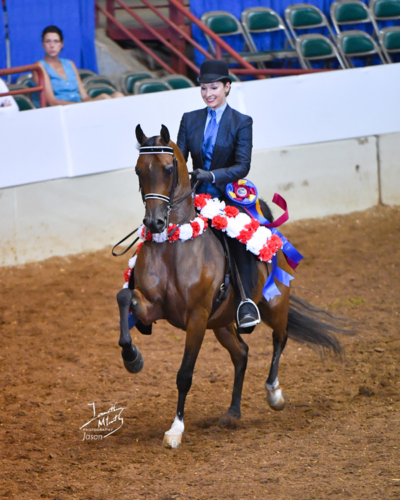
Photo provided by Lindsay French.
Lindsay: I’ve been riding since I was 7, when my parents got me lessons for my birthday, so about 32 years. I ride Arabian horses, and I show English Pleasure, which is Saddle Seat English.
You are judged on how you look on the horse, how the horse looks, and how you two fit together. You’re responsible for being able to have the horse do what the announcer asks. You have to be able to cue and guide your horse, steering it through the classes. There are a lot of horses in the ring with you, so you’ve got to be aware of everything going on around you.
With this, the seated figure eights we do in a Gyrokinesis class come to mind whenever I go to a show. You have to know what’s behind you and have that awareness of what’s behind you. Whenever you’re doing figure eights seated, you become more aware and it helps awaken that back area of your body, if it’s not already.
I think that’s a neat tool to use before going into the show ring. With all that is going on, the less you have to worry about yourself and your tension, the better.
Cina: Given that you’ve been riding for so long, tell me what it does to the body and what sorts of challenges you face in movement.
Lindsay: When riding horses, your adductors (AD), or your inner thighs, are very strong, your hip flexors are shortened — similar to what happens to people when they spend a lot of time in sitting positions in everyday life — and your back is very strong and stiff and doesn’t move much. Your pelvis may move and slide in the saddle, but your back is upright and strong, and sort of statuesque looking. There is not a ton of motion or movement in the spine.
Meanwhile, you’re gripping with your inner thighs, engaging the upper arms and upper back, and trying to hold on and stay balanced on the horse, all at once. It’s a lot of core work, for sure. Staying balanced in both stirrups is really important because a horse can feel if you’re off to one side. Just making sure your body is balanced is a big challenge.
When addressing these issues, Pilates’ magic circle, leg circles, and things like that have really helped work the inner thigh because you’re squeezing the circle or ball in between the legs.
But in the Gyrotonic work, I have found more of the lengthening and strengthening. I think the angle of the pulley lines in the Pulley Tower is a big help in getting into the hamstrings to help lengthen them. The hamstrings get so tight because you’re constantly gripping with your adductors and your hamstrings to hold onto the horse. Also, your legs are pretty much in a constant bend. They may straighten a little as you stand up in the saddle, but they don’t fully straighten and are always shortened. So, the hamstrings work on the Pulley Tower is really helpful.
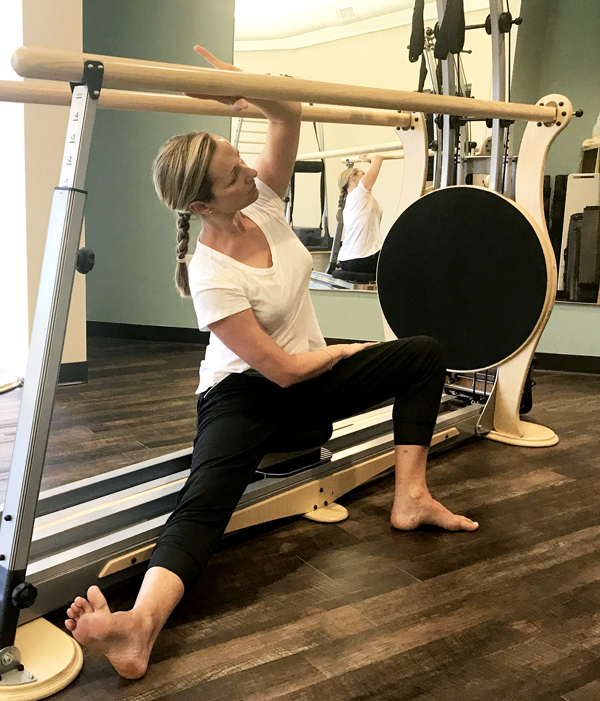
Specifically, what has helped me with a lot of these issues is the leg circle work on the Pulley Tower, and the sliding side-to-side on the Jumping-Stretching Board (JSB). I love the sliding side-to-side; this is when you’re on the disc facing sideways, and you press through one leg while extending through the other leg. Then, to slide to the opposite side, you pull through the extended leg and extend the other. You can also add the side bend.
This work helps get that connection all the way through the body. The lengthening through the inner thigh, while pulling with the other leg, is not something we do in horseback riding, and it’s something that is lacking. I feel that in riding, we need to work on that in order to keep the body balanced. Otherwise, you are constantly shortening, shortening, tightening, engaging… and not getting that release. We need to teach the muscles to release and work at the same time.
By sliding side-to-side, you can push through one leg, pull with the other, and engage the inner thigh as it’s stretching. You’re also in a seated position, so it’s similar to horseback riding.
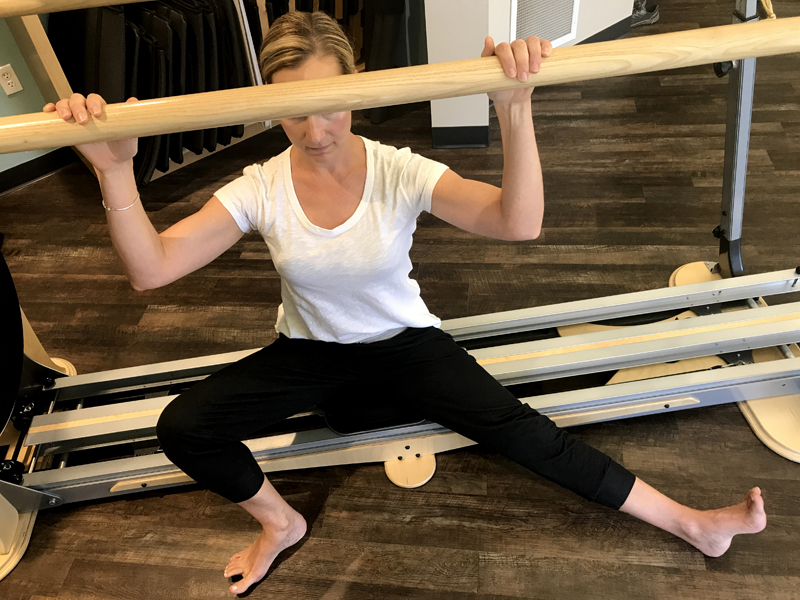
Your core is also working because when you add the lateral flexion, or the side bending and the stretching of the arm overhead, that all helps in opening up the spine a bit, which in horseback riding is very stiff. Again, it’s really helpful in getting that whole body connection from the heel, up through to the rib cage, and if you extend the arm, up through the arm as well.
Cina: What have been the biggest personal challenges with your body?
Lindsay: Definitely hip flexor flexibility. Also hamstring length, but that is easier to work on.
In the Gyrotonic Method, for instance, there is something we call the matador pelvis. This has been very challenging for me, especially when on “tall” knees. The flexors are just so tight, and my pelvis wants to be in an anterior tilt. This is mostly because of that tightness, but also when you are sitting on a saddle and riding, your whole spine is almost in extension. Your pelvis is slightly anterior, and you’re sitting on top of your sits bones, if not a little in front of them (but definitely not behind them). You’re almost in a slight arch.
So opening up the spine and getting more mobility in the spine is where the Gyrotonic work is very beneficial.
Cina: Is there anything in particular that has helped you get into that matador pelvis?
Lindsay: Something that is similar to horseback riding, but is a different leg position, is when you’re on your knees on the JSB, on the rotating disc, lifting and lengthening through the whole body, up through the spine, from the knees to the head. That has helped me find it.
Then you take a little sit and rotate and lengthen on the other side. It’s like you’re trotting, or posting on a horse when you’re in the saddle, but you don’t have that hip flexion as much because you’re coming up and fully extending and opening up through the front of the pelvis.
You then go back, slightly hover and engage the abs while balancing, which is familiar in riding. Then you come up off it and open up, lengthen the front of the quads opening up through the knee, which is different than on a horse, open up the front of the hip fully and then lengthen the abs and the hip flexors.
Cina: Sounds like the support of the Gyrotonic equipment has been really useful for you.
I think the JSB is the piece of equipment that has been the most helpful for me. When I first started the Gyrotonic work, it was the Pulley Tower bench that was the most challenging. In the basic arch and curl, I couldn’t get my sacrum and my pelvis to keep the arch when I went out toward the high V position on the handle units. My pelvis would want to flex and get into a more posterior tilt, and I’d lose my arch as I’d go out. I was so used to sitting up straight, so I was having a hard time rocking forward and getting in front of my sits bones while keeping that arch in my pelvis the whole way forward.
The curl was better, but it still wasn’t very big. My lower back was really, really tight. People thought I was a dancer because a lot of spinal issues that are associated with dancing, like sitting up so tall all of the time, are similar to horseback riding. You’re in that constant “proper posture.” But it’s not really the proper posture.
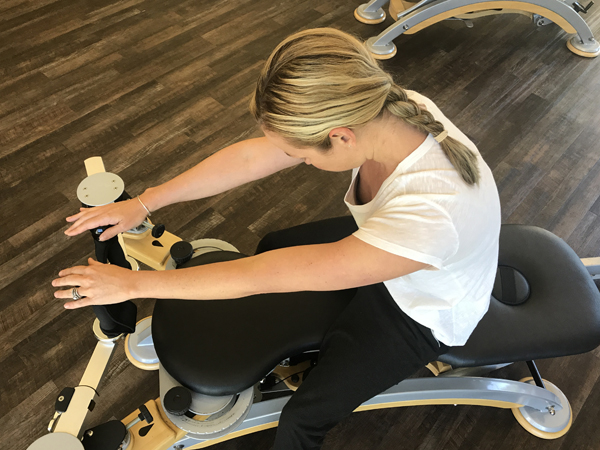
One thing that Pilates introduced me to, but that the Gyrotonic work took a step further, was the idea of the alignment of the knee and the foot. In riding horses, your knees are often holding on while your heels are digging in. You’re completely misaligned, which can cause a lot of knee, ankle and foot issues.
Straddling the bench on the Pulley Tower was like sitting on a horse, which reminded me to look down and see what my knees and feet were doing whenever I was opening and closing my knees for the arch and curl. I began working on my knees and toes to get them to face in the same direction in proper alignment, instead of my knees hugging the bench and my toes facing out.
Cina: How long did it take before you noticed a difference in your body that translated to your riding?
Lindsay: I’d say it happened pretty quickly, in the first couple of months, because I’m very aware of what my body is doing. When I was in the Gyrotonic room, I would think about riding, because that is my passion, and I would work towards learning how to ride more anatomically correct.
I still have a problem, though, with leaning to one side. When I’m trying to compensate because the horse is acting up, my ribs shift down on my left side, and my right side lengthens. I go to my default position, which for me is leaning. Every time, after I ride, I have to come into the studio and jump on the equipment to get straightened out.
I like doing the hamstrings series, lying on my back with feet in the straps, because it helps to lengthen out that whole back line of the body. It allows my back to rest on a supported platform and for all those muscles to relax while I’m lengthening out the back line of the body.
Then I get up and usually do the inner thigh stretches on the JSB and stretch out the sides by taking the arm over head. That helps me to feel the imbalance because my left side is usually a little tighter.
After this, I’ll go to moving my spine. But I have to lengthen my hamstrings and inner thighs first before I can get into that arch on the handles.
Cina: So, you still struggle with that?
Lindsay: Yeah, definitely. If I’m at a show for week, or even a weekend, and I’ve been riding the whole time, I have to fix myself. The Gyrotonic work is great preparation for riding and making me stronger for it. I do feel strong when I ride because all of the smaller muscles, the core, the balance, everything is there. I don’t have to worry about that aspect of it.
After riding, the Gyrotonic work puts me back where I need to be in order to prevent injuries. If I didn’t practice the Gyrotonic Method, I can’t even begin to think where all I would be sore. I know my back, my hips, and my knees would be. I’d have misalignment in the feet, knees and hips, and I’d have a stiff back and stiff shoulders from locking them in and holding on.
I tell all the girls that are young and graduating the youth division to start doing the Gyrotonic Method as soon as they can. I also tell them there is a stool and mat version called the Gyrokinesis Method. I have found that the Gyrokinesis Method also really helps me. For example, sitting on the stool in format 1 and doing the leg series, with just the simple side kick position where you send one leg off to the side and then do a side bend, imitates the JSB side-to-side move. It’s so beneficial for me to get that scoop of the femur bone, dropping into the pelvis and hip, and also getting the spine to move while opening up the side.
Cina: Going back to the basic arch and curl, were there any other specific exercises that helped you better get into that curl in the lower back?
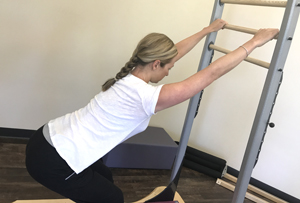 Lindsay: For me to get into the curl, the biggest benefit was laying out a long towel, sitting on one end of it and pulling the other end up behind me, up and over my head to create a little hammock for me to lean back into. With your feet on the floor or bench, you just curl back into that towel and try to get the lower back and mid back to relax, release and lengthen while pushing the head, the upper, mid and lower back all into that towel. Knowing that I did not have that positioning correct was the biggest a-ha moment for me. The towel helped me because it gave me a good tactile feel on the back of my body.
Lindsay: For me to get into the curl, the biggest benefit was laying out a long towel, sitting on one end of it and pulling the other end up behind me, up and over my head to create a little hammock for me to lean back into. With your feet on the floor or bench, you just curl back into that towel and try to get the lower back and mid back to relax, release and lengthen while pushing the head, the upper, mid and lower back all into that towel. Knowing that I did not have that positioning correct was the biggest a-ha moment for me. The towel helped me because it gave me a good tactile feel on the back of my body.
Another thing that has been helpful is hanging from the bars on the Archway. Doing that loosens up my lower back and hamstrings at the same time. You use your feet to push through your legs, the legs bend and straighten, and the back arches and curls while the arms bend and straighten.
Any of those combinations really helped me get the hamstrings lengthened, get the feet connected to the hips in proper alignment, and get the spine mobile and strengthened, all at once.
Cina: What about for the arch? Anything specific that has really helped with that?
Lindsay: For the arch, I think that the JSB work has been the best. There is a move on the JSB where you sit at the end of the track, facing the end of the machine, and you have a foot on each side of the track while your hands are holding onto the bars. When you go into the arch, you can use the bars to help pull the chest up to make the arch. When you get the upper back arch, you can push the disc back to get in front of the sits bones.
That tactile feel of moving the disc back and rocking in front of the sits bones was really good for me.
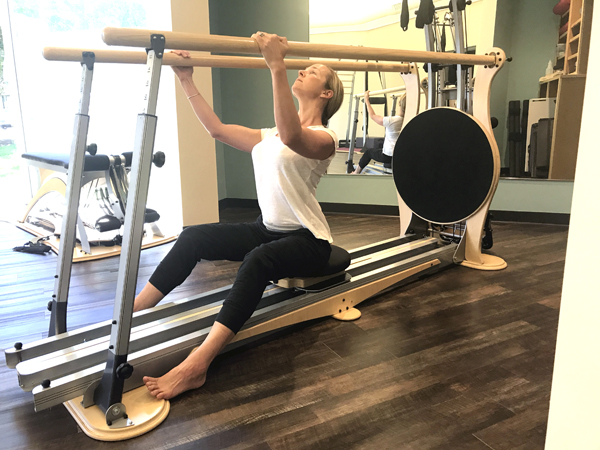
Then, to counter that and go into the curl, you use your arms on the bar to kind of pull down and help create that length. You can push into the feet and then roll the disc forward and rock behind your sits bones. You’ll feel the disc wanting to move, or wanting to kind of jump back behind you, because your back doesn’t want to go into the full curl.
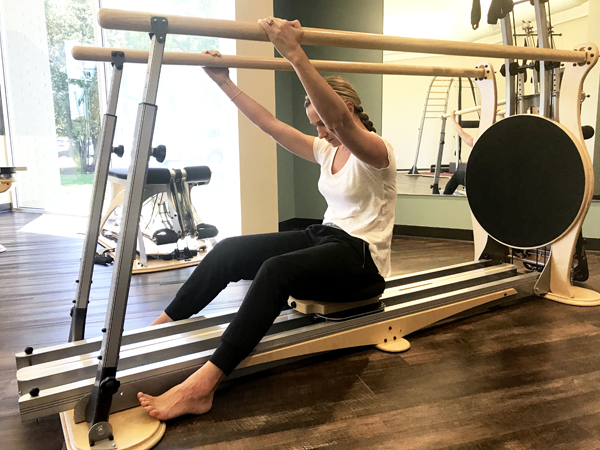
That was interesting, because each time I could go back a little further because it was lengthening the hamstrings and loosening up the pelvis into that slight anterior like arch. There was a time when I could start the curl, and a lot of times not finish the curl because my pelvis just wouldn’t go any further and my lower back just wouldn’t allow it. On the bench, you might feel you are doing a full arch and curl, but then you get on the JSB and sit on that disc in the sliders and the pelvis just doesn’t move. You quickly realize that you’re not really moving your pelvis.
For the cantering on a horse, you slide in the saddle more, so that’s a little bit more of a slight curl and not as much of a arch. This movement is good to help with cantering and sitting in the saddle.
Cina: What are the biggest benefits you’ve noticed in your riding since you started this work?
Lindsay: Well, one is that I can get on a horse without a step stool, which is very nice. Riders use step stools a lot because their hips are so tight, and they just don’t have the flexibility or strength. They may be able to get their foot up into the stirrups, but then they can’t push themselves up onto the horse. So, that’s what the Gyrotonic work has done for me: I can get on a horse. First steps first, just getting on!
Also, I think the core work and the narrowing of the pelvis is a lot like what you do when you’re posting, or sitting, on a horse; you’re engaged the whole time. Teaching your muscles to release when you come out of narrowing, or teaching your muscles to engage as you go into narrowing, comes in handy when you’re on a horse.
So that has been a big help, because a lot of times it’s easy to stay really tense on a horse and constantly stay engaged. But through narrowing, I’ve learned that I need to relax a little, and I’ve learned how to relax. It’s a little like coming down from narrowing; you sit a little heavier, you let your femur bones go a little wider, you relax that magnetic belt around your hips, and just let those magnets pull away from the center.
It’s that same idea on a horse. Horses can sense when you’re tense. If all of your muscles are tense all the time, and you can’t relax, it’s not going to work. The horse gets anxious and starts to get a little rowdy. So learning how to do this has been a big help.
Cina: You are also a Gyrotonic and Gyrokinesis Trainer. Have you noticed that horseback riding has helped you in any ways as a trainer?
Lindsay: I’ve learned a lot about the idea of pressure and what’s too much, or what’s not enough. Horses are a lot like people; they all have their own personalities, and you’re always trying to read what they want. Whether you are just petting or scratching them, or trying to steer them in a certain direction, they can feel the slightest change in your pressure. Even just closing your left fingers on the rein could tell the horse to go left, or you could pull your left arm back and turn their whole body sideways.
The idea of too much can definitely be too much, and too little may not get the desired result.With a horse, you learn to start small and then slowly and gradually increase. If you go too much, too fast, you’re going to scare them.
This is very apparent in teaching the Gyrotonic work too, because you use what we call “hands-on” to guide the client. You want it to be beneficial. You don’t want to be too aggressive. You want to lightly encourage them to go in the correct direction as opposed to “maneuvering” or pushing them into it. Neither the client nor the horse would like you after that!
Cina: With all of this, in summary, why should a horse rider consider practicing the Gyrotonic Method and/or Gyrokinesis Method?
Lindsay: There are a lot of reasons! Mainly, to prepare you to ride, and then to put yourself back together after you ride.
Horseback riding is not easy on your body. It definitely strengthens a lot of areas of your body, but that leaves those opposing muscle groups all open for weaknesses because it doesn’t strengthen them. For instance, your abductors (ab), or outer hips and thighs, glutes, the biceps, and maybe even the pecs, are all a little weaker.
With the Gyrotonic work, you strengthen those for more balance. Really, this work just helps with everything. It helps keep me in shape and balanced, which has allowed me to stay nationally competitive throughout my adult years, in a vigorous sport.
Cina: Thank you for taking the time for this, Lindsay. I’ll see you next week!
Leave us a comment below with your thoughts!
To find a studio where you can have a personal experience with the Gyrotonic Method or Gyrokinesis Method, please visit our Studio Finder to locate trainers and classes near you.

Cina Canada is a GYROTONIC® Trainer and Media Coordinator for GYROTONIC® International Headquarters.
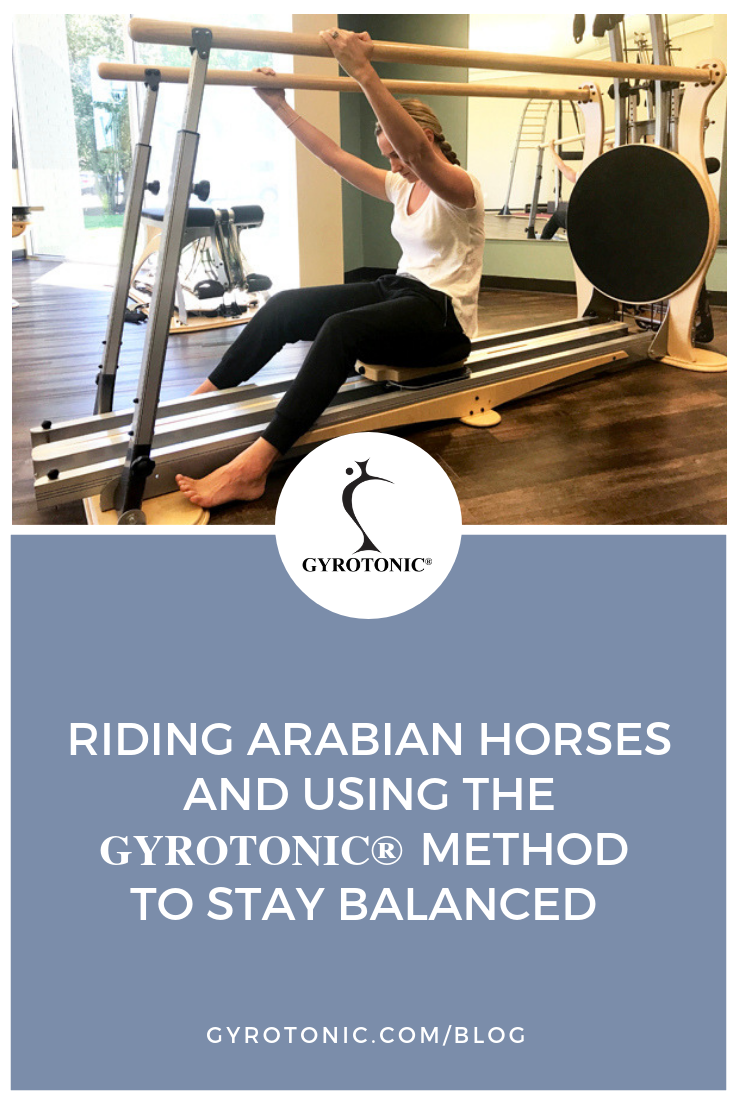
Pin for later!
